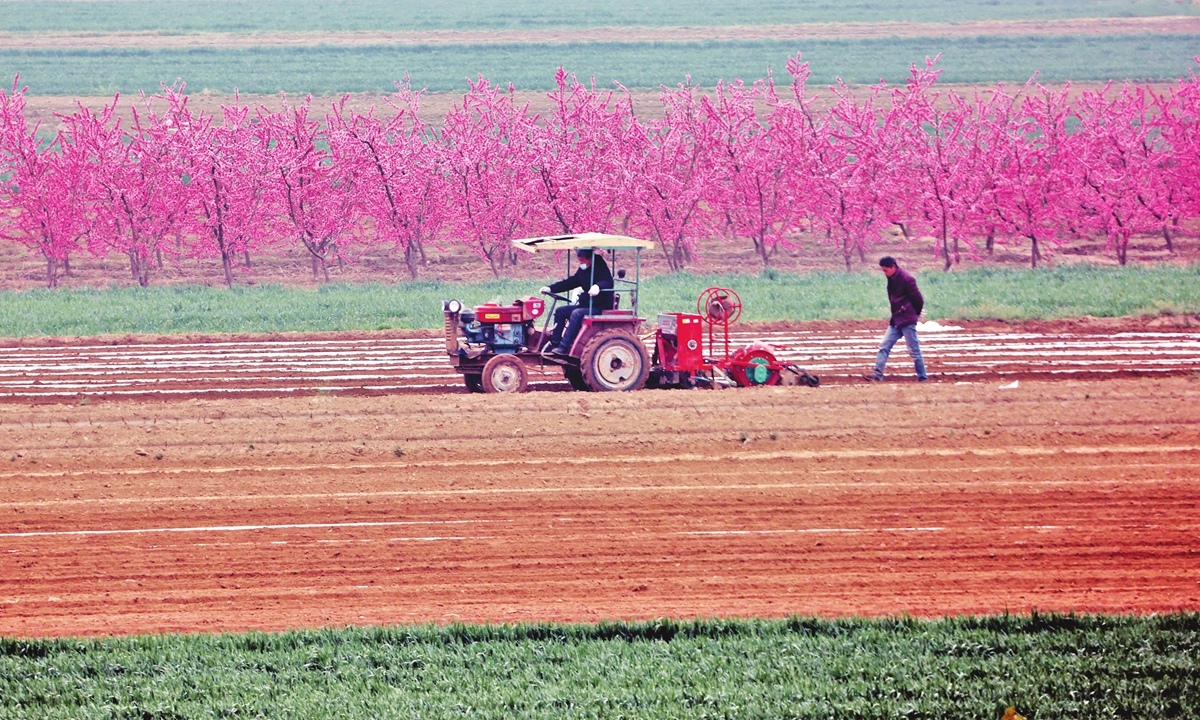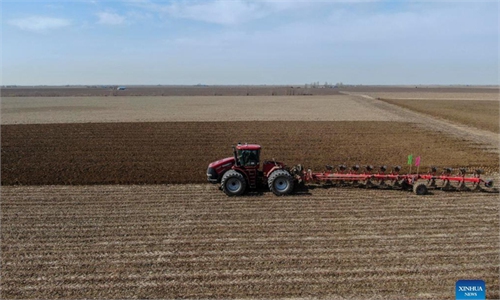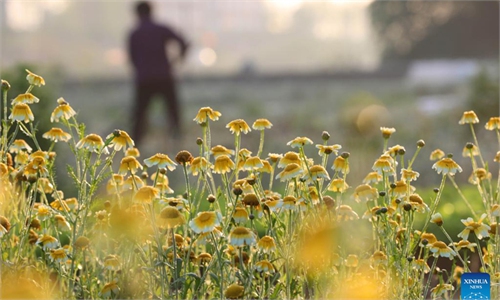
Farmers work hard in the field during the annual spring farming on March 23, 2022 in Dali County, Northwest China's Shaanxi Province. Photo:cnsphoto
China's spring farming, the first major battle to ensure sufficient grain production for the whole year, is in full swing across the country, despite challenges posed by COVID-19 and other factors, as officials are taking various efforts to support farmers and ensure food security.
Farmers told the Global Times that the government is taking measures to support them, including setting up "green channels" for the transportation of agricultural materials, and they have the confidence to see a smooth planting season and harvest.
China aims to ensure the full-year grain output in 2022 stays above 650 billion kilograms, according to this year's government work report.
"My corn planting is not being heavily impacted by the epidemic this year," Gao Guangyong, a farmer in Dongfeng county in Northwest China's Jilin Province, which is facing a severe wave of COVID-19 epidemic, told the Global Times on Wednesday.
Gao provides agricultural services for more than 1,000 mu (404 hectares) of land in Jilin, China's second-biggest corn-growing province, and he himself has farmland of 100 mu as well.
He said that the agricultural materials and machinery for spring farming across the province can be safely delivered to farmers without any blockages.
Gao's remarks were echoed by Zhang Shenglong, a seed wholesale dealer in Jiutai of Changchun city in Jilin Province.
Zhang told the Global Times on Wednesday that the government is helping the recovery of agricultural production through different channels, including having farmers order the agricultural materials online and suppliers send materials by door-to-door services, to ensure the purchases are not being delayed.
The officials in Jilin Province said on Tuesday that the province is making every effort to ensure that stranded farmers in Changchun and Jilin can return to their hometowns to carry out spring farming, and supplies of seeds and fertilizers can reach the fields in time.
Epidemic control and spring farming are both key priorities, the officials said.
According to data released by the Department of Agriculture and Rural Affairs of Jilin Province, as of April 3, 91.17 percent of the seeds for spring farming and 73.99 percent of the fertilizers were ready.
Despite challenges such as COVID-19 and the delayed planting of winter wheat in a few areas, Tang Renjian, minister of agriculture and rural affairs, is confident that China can ensure a bumper harvest of summer grain thanks to policy and technical support, and improving grain crop conditions.
"We are capable of ensuring that more than 1.4 billion people have enough food to eat. Our rice bowls will be held more firmly in our own hands and filled with better and healthier food," Tang said in March, according to the Xinhua News Agency.
Despite China's efforts to ensure food security, some foreign media outlets have been using the Russia-Ukraine conflict to hype food supply issues in China.
For example, the Voice of America, a propaganda arm of the US government, claimed on March 16 that the Russia-Ukraine conflict had pushed up global commodity prices for wheat and other items, and that the external effects of the Russia-Ukraine war may have made China's food shortage crisis worse.
However, Chinese experts said that the Ukraine situation has had little impact on domestic food supplies or food security.
Russia and Ukraine are the world's major exporters of wheat, corn and sunflower oil. For China, Ukraine is the main source of corn and sunflower oil imports.
However, considering that total corn imports account for less than 10 percent of consumption, and the stocks of alternative oils and fats related to sunflower oil are sufficient, domestic wheat and rice do not need to rely on imports, Lu Jiarui, an analyst from Guosen Securities.
Ukraine is China's main source of corn imports, and the corn in China is mainly used as feed, and wheat is also used as feed, so there is little impact, Li Guoxiang, a researcher at the Rural Development Institute, the Chinese Academy of Social Sciences told the Global Times on Wednesday.
Soybeans are the only major crop where China relies heavily on imports - 84 percent of domestic consumption in 2021, mostly from the US and Brazil, CNBC reported, citing Citi.
China is ramping up the production of soybeans and oilseed crops through expanding growing areas and breeding good seeds.
The nation's northernmost Heilongjiang Province, the largest production and supply base of high-quality soybeans in China, plans to expand the soybean planting area by 10 million mu this year.
However, global commodity prices have pushed up China's agricultural planting costs, in addition to cross-provincial transport bottlenecks, according to experts.
Zhang told the Global Times that the price of chemical fertilizers per ton is about 1,000 yuan ($157) higher than in previous years, an increase of about 30 percent.
Hu Dan, a staffer at an agricultural cooperative from Wuhan, Central China's Hubei Province told the Global Times that compound fertilizer per ton now is about 4,000 yuan, up from 3,000 yuan a year earlier, and the prices of pesticides have also risen.



